Search
When?
-
The history of the internet: 10 life changing milestones
17 June 2022 Everyone here at MOTHandRUST has been talking about the Web Design Museum. Fascinating!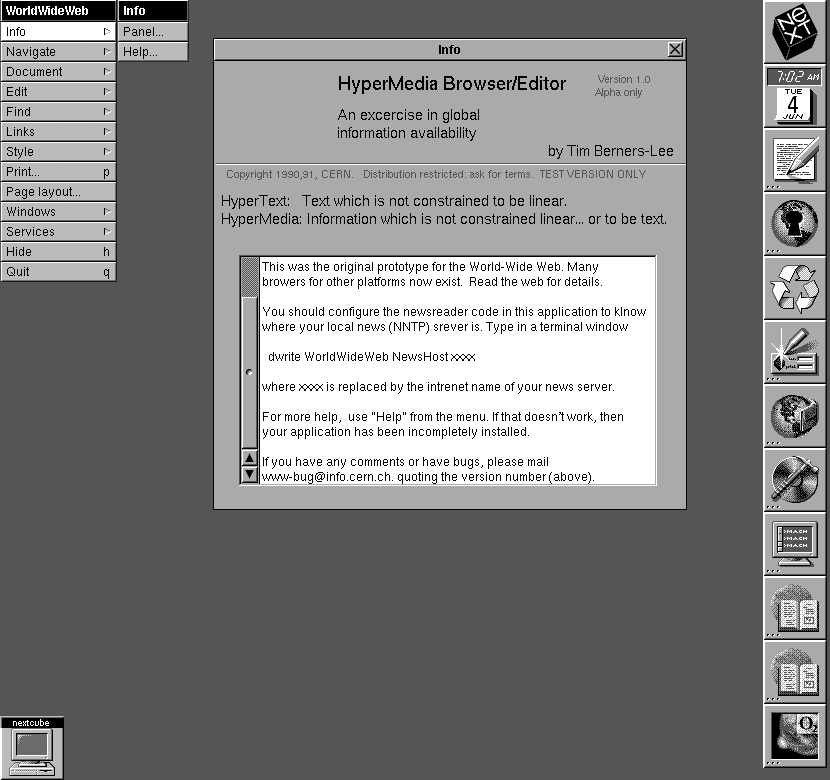 December 25th, 1990At CERN, a Swiss research center, a British physicist and internet pioneer Tim Berners-Lee created the world's first web browser, called WorldWideWeb.
December 25th, 1990At CERN, a Swiss research center, a British physicist and internet pioneer Tim Berners-Lee created the world's first web browser, called WorldWideWeb.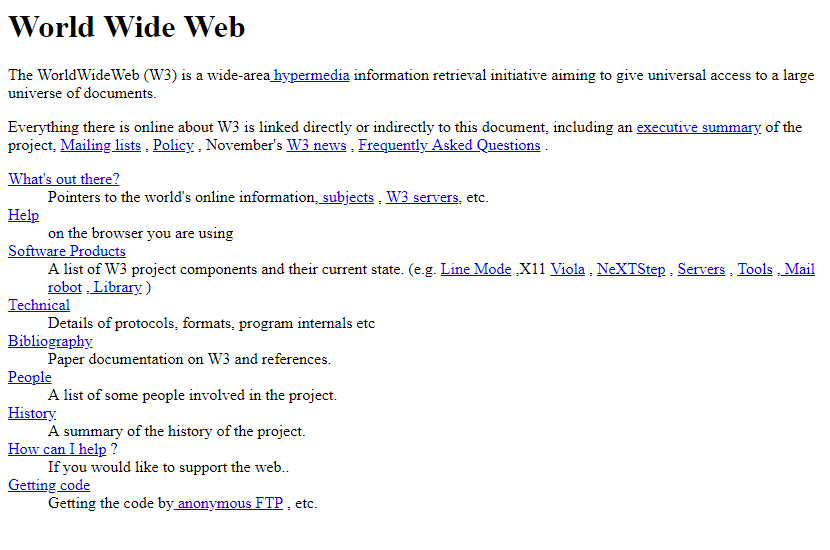 August 6th, 1991Tim Berners-Lee launched the world's first website at:Unfortunately, the original website has not been preserved and the link shows only its 1992 copy. However, it is still interesting to see what the world's first website looked like. No images would be found on the web until 1992. So, not as exciting as most would hope?
August 6th, 1991Tim Berners-Lee launched the world's first website at:Unfortunately, the original website has not been preserved and the link shows only its 1992 copy. However, it is still interesting to see what the world's first website looked like. No images would be found on the web until 1992. So, not as exciting as most would hope?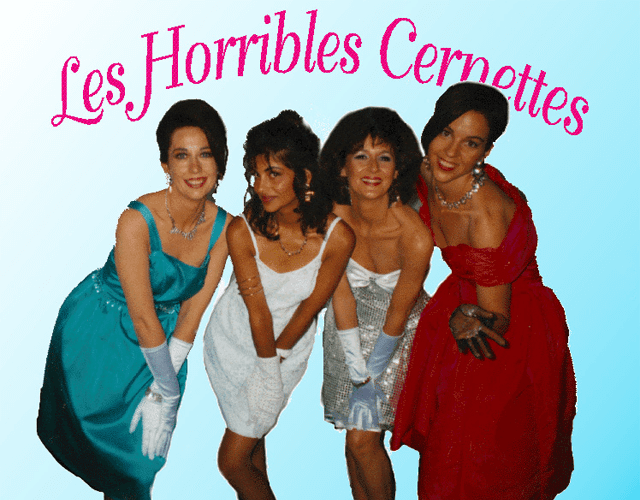 July 18th, 1992Silvano de Gennaro, an Italian computer scientist who worked at CERN research labs, was asked by Tim Berners-Lee to scan and upload a photo of a parody pop-group called Les Horribles Cernettes (The Horrible CERN Girls) onto the info.cern.ch website. This photo became one of the first images to be published on the World Wide Web.
July 18th, 1992Silvano de Gennaro, an Italian computer scientist who worked at CERN research labs, was asked by Tim Berners-Lee to scan and upload a photo of a parody pop-group called Les Horribles Cernettes (The Horrible CERN Girls) onto the info.cern.ch website. This photo became one of the first images to be published on the World Wide Web.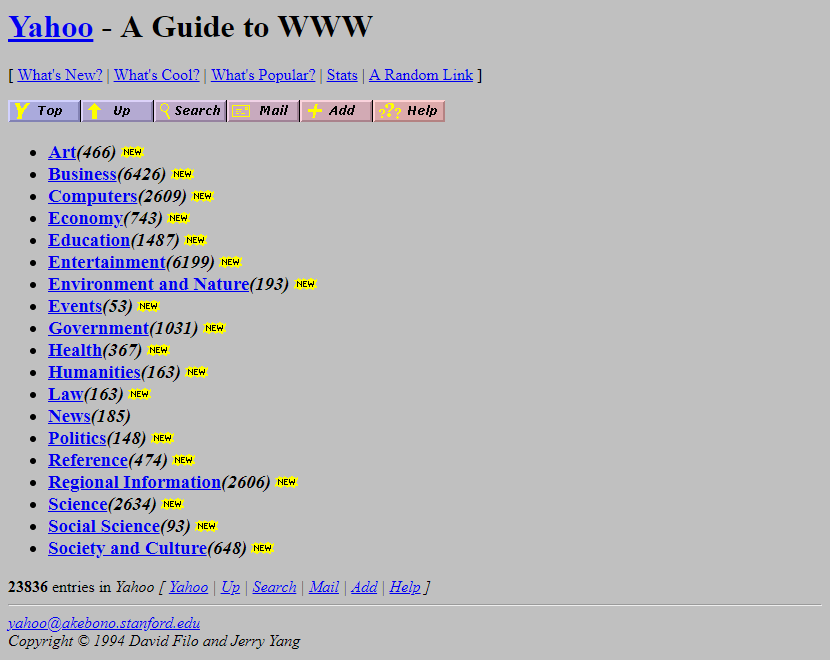 January, 1994Jerry Yang and David Filo, two Ph.D. students from Stanford University, created a list of websites entitled "Jerry and David's Guide to the World Wide Web." In March 1994, the portal was renamed Yahoo!
January, 1994Jerry Yang and David Filo, two Ph.D. students from Stanford University, created a list of websites entitled "Jerry and David's Guide to the World Wide Web." In March 1994, the portal was renamed Yahoo!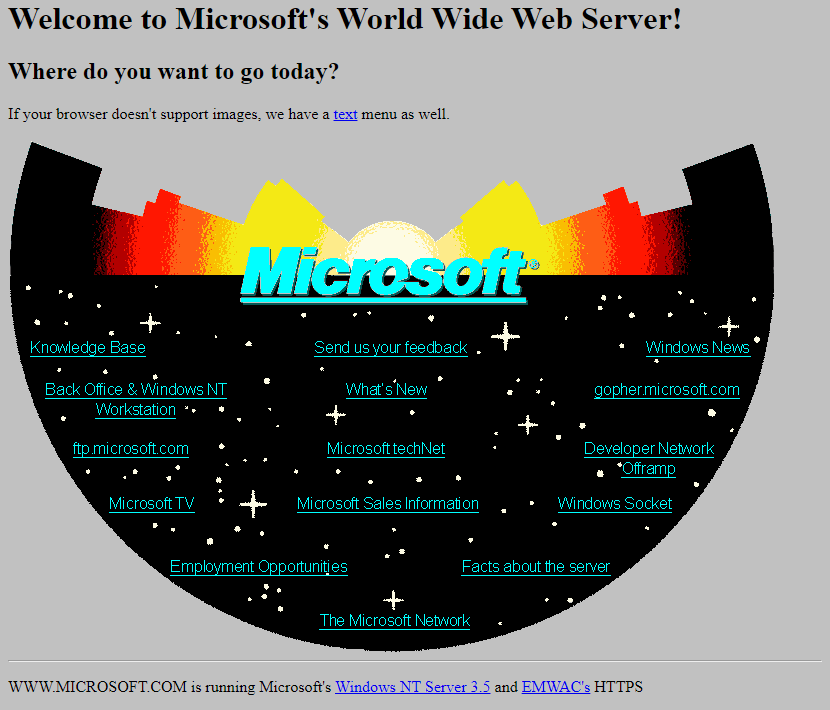 1994Microsoft.com launches. A note on the homepage says, "If your browser doesn't support images, we have a text menu as well.".
1994Microsoft.com launches. A note on the homepage says, "If your browser doesn't support images, we have a text menu as well.".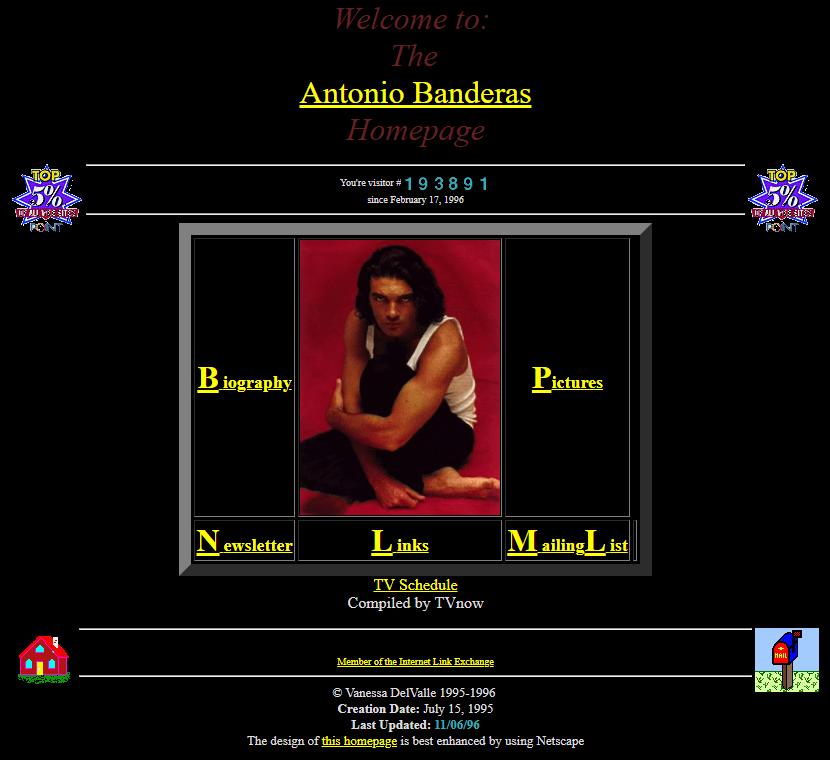 July 15, 1995Still struggling with his English, actor Antonio Banderas was an early pioneer, using the web to introduce himself to Hollywood
July 15, 1995Still struggling with his English, actor Antonio Banderas was an early pioneer, using the web to introduce himself to Hollywood 1996This may be Apple's first site? Early sites tended to look like items IRL as this helped with usability. For example, having what looked like actual buttons would help people who were not familiar with the internet understand what they need to do.
1996This may be Apple's first site? Early sites tended to look like items IRL as this helped with usability. For example, having what looked like actual buttons would help people who were not familiar with the internet understand what they need to do.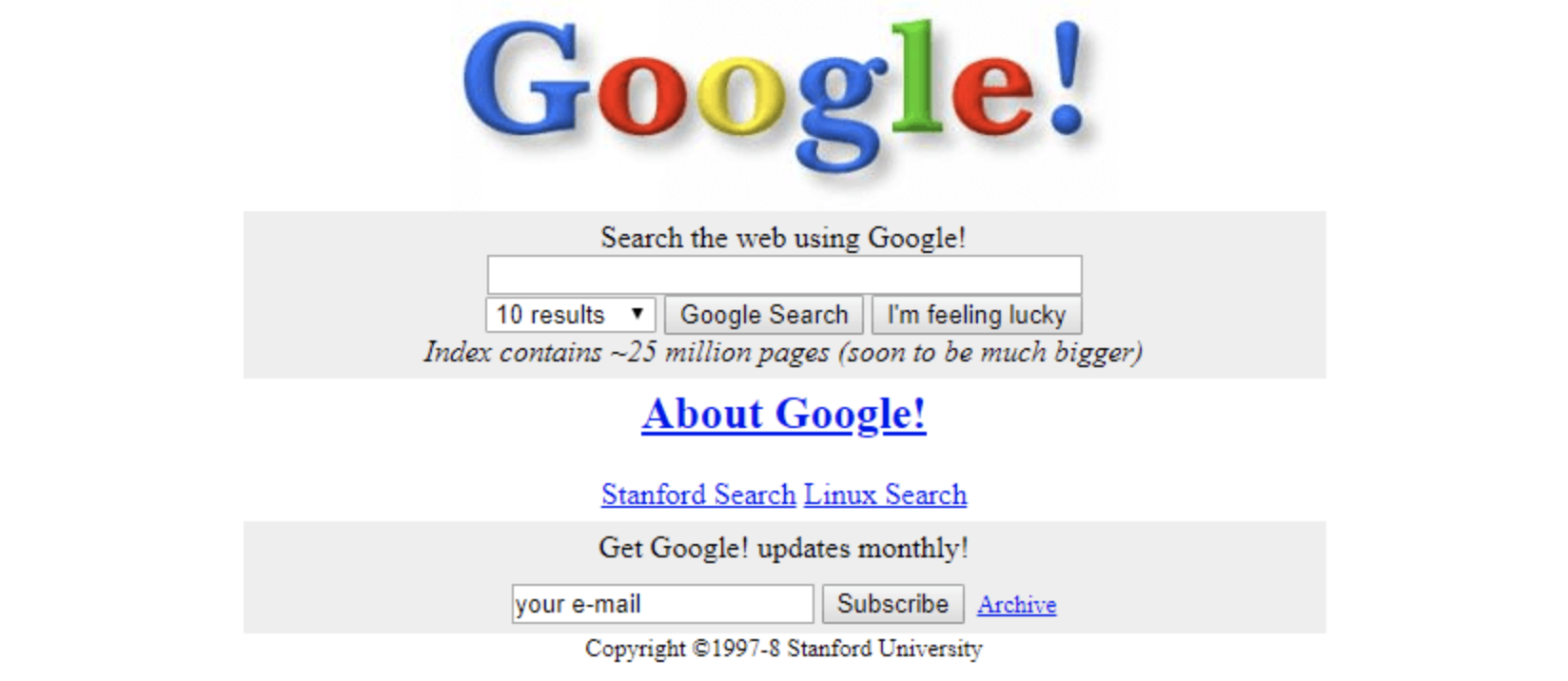 September 4th, 1998Ph.D. students from Stanford, Larry Page and Sergey Brin, created the Google search engine. It was a research project whose aim was to find relevant search results using a mathematical algorithm. The name Google is a deliberate misspelling of the word googol, which refers to a very high number.
September 4th, 1998Ph.D. students from Stanford, Larry Page and Sergey Brin, created the Google search engine. It was a research project whose aim was to find relevant search results using a mathematical algorithm. The name Google is a deliberate misspelling of the word googol, which refers to a very high number. November 14th, 2009"Flat design" didn't really come along until after 2010. Microsoft's site for the Zune multimedia player is considered to be one of the first uses of flat design in user interface. We no longer need the online world to look like real life.
November 14th, 2009"Flat design" didn't really come along until after 2010. Microsoft's site for the Zune multimedia player is considered to be one of the first uses of flat design in user interface. We no longer need the online world to look like real life.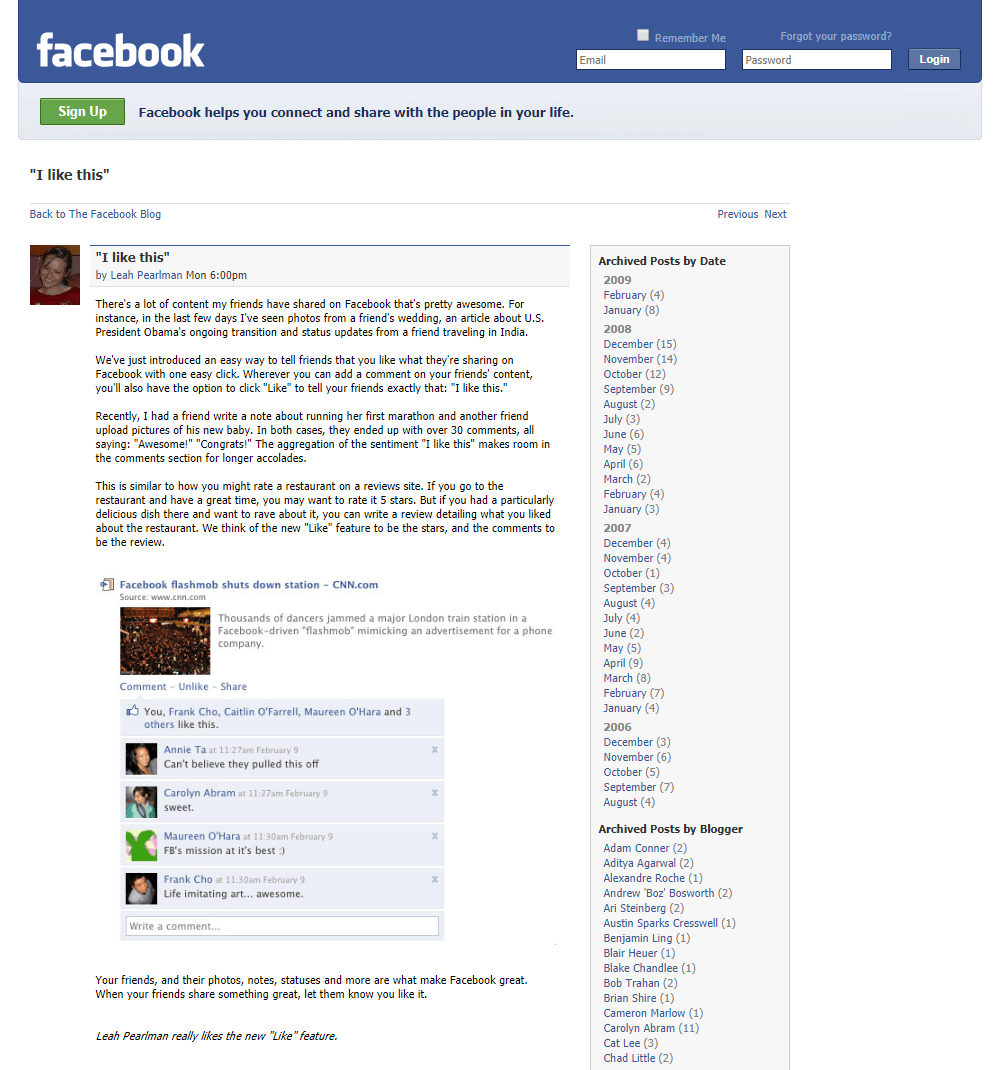 Feb 9th, 2009The internet social networking site Facebook introduced its “like button” feature for the first time. The announcement post above explains how some FB posts could have over 30 comments, all saying 'awesome!' 'Congrats!' The aggregation of the sentiment 'I like this,' makes room in the comments for longer accolades." What was life was like before 2009 when you couldn't like things online?Posted in: web
Feb 9th, 2009The internet social networking site Facebook introduced its “like button” feature for the first time. The announcement post above explains how some FB posts could have over 30 comments, all saying 'awesome!' 'Congrats!' The aggregation of the sentiment 'I like this,' makes room in the comments for longer accolades." What was life was like before 2009 when you couldn't like things online?Posted in: web -
Brigitte Reiffenstuel Costume Design
10 May 2022 
Brigitte Reiffenstuel’s award-winning costumes have been seen on stages all over the world for the past twenty years, from the MET in New York to London’s Royal Opera House to La Scala Milan.
Though she is very well-known in the realm of opera, her career continues to expand into the wider fields such as film, theatre, and advertising. She wanted her new site to show this. We were introduced to Brigitte by our long term friend and client, London set designer, Michael Levine.
Her site's key audience includes production companies and directors. Being very busy, they tend to very quickly skim through portfolio sites. Therefore, the overall impression of a scrolling page was important for the new site, as was effective storytelling with images rather than text.
Our new site for Brigitte scales all images to the optimum size for the viewer's device, so image zooms are not required. Both portrait and landscape formats are portrayed equally well. The site features an easy, flexible layout system where she can upload, test, rearrange and position all images until they are curated for maximum impact and storytelling. This is boosted by the use of complementary background colours for each project.
Finally, there is quite a bit about Brigitte on the web and Google search results vary widely; examples of her work may be dated, and so on. With search engine optimisation, a Google search will lead users directly to her site more frequently, meaning she has more control over how she is portrayed online.
brigittereiffenstuel.comPosted in: web MandR work -
'Twas the night before Christmas
24 December 2020 
This morning we launched a special Christmas video pop up on the Actors' Benevolent Fund site!Conceived by HRH The Prince of Wales in an effort to support the work of the ABF, "'Twas the night before Christmas," was recorded at Clarence House in December 2020 by an ensemble cast featuring the ABF's patron HRH The Prince of Wales, HRH The Duchess of Cornwall, ABF President Dame Penelope Keith, Daniel Craig, Dame Judy Dench, Ncuti Gatwa, Tom Hardy CBE, Joanna Lumley OBE, and Dame Maggie Smith.MOTHandRUST has been working with this incredible 135-year-old charity on their site and other design work for a few years and today their work has never been so important.Happy happy holidays!Posted in: web MandR news -
Flashback Friday: the Lieber Institute for Brain Development (LIBD) site
20 November 2020 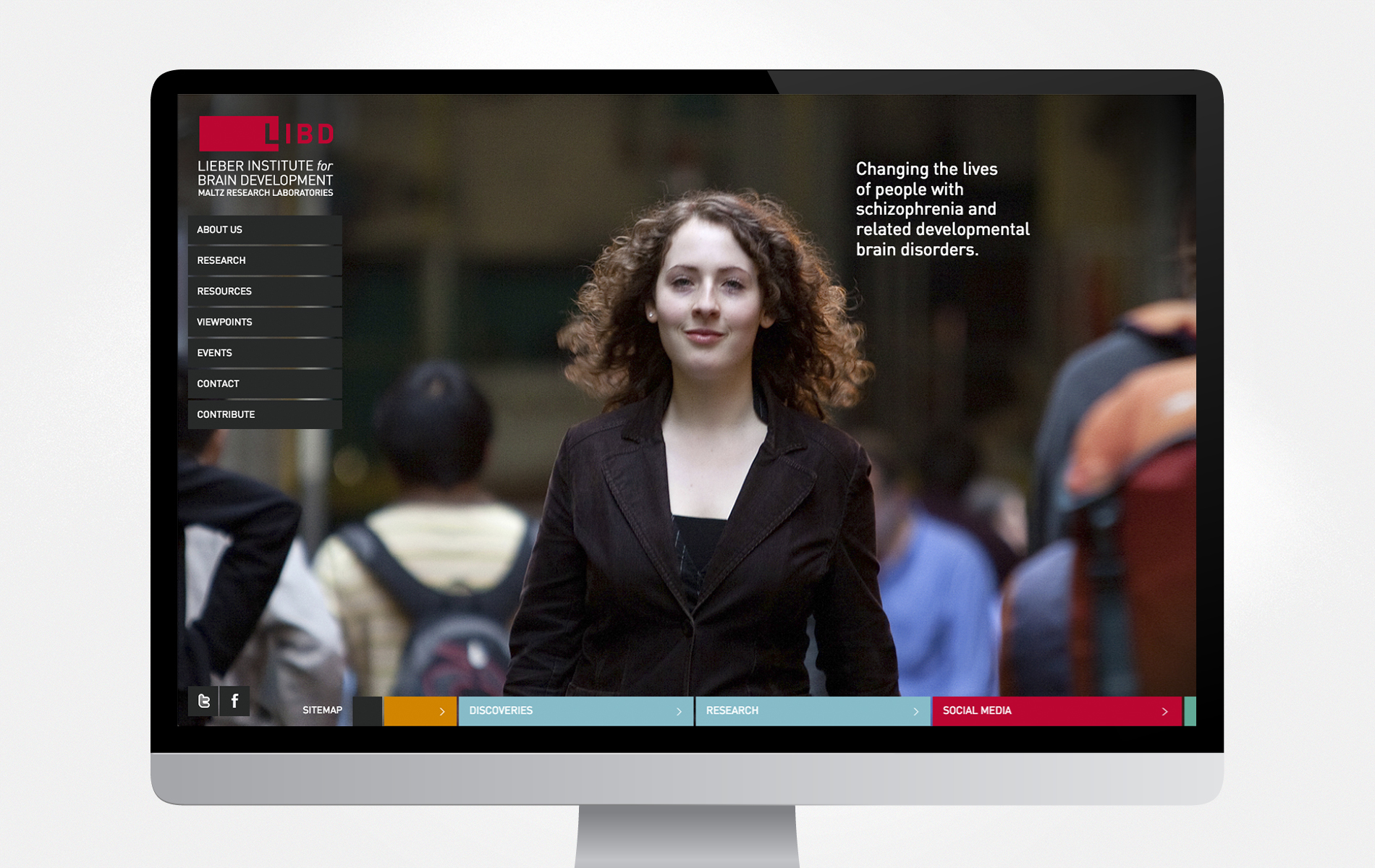
We've come a long way in the past 10 years since we launched the LIBD site… It was right around this time in particular, 2010/11, that the digital sphere went through a rapid growth spurt, testing everyone’s ability to adapt!
Partly because we are about to enter another new decade, and partly because we are (still) going through the archive of our work to finally update our site, we’ve been thinking a lot about how web design has evolved over the past decade.
Flash
One cannot think back about the good old days without thinking about Adobe Flash right? In the ‘00s, it was The Technology that allowed developers to incorporate animation and interactive content to sites.
In early 2010, MOTHandRUST launched our last Flash site. Shortly before that, all designers at the branding agency I was working at were enrolled on a rather lengthy Flash course. No one wanted to see that its demise was coming. But in April 2010, Steve Jobs wrote his “Thoughts on Flash,” a moment many have defined as “The Death of Flash.” Suddenly it was on the way out and everyone had to (sooner or later) accept this and adapt.
The LIBD site used interactive HTML5 Canvas animations that were just as sophisticated as Flash, but these could be viewed without having to install it (a major downside of Flash). This meant that it worked across most devices, even mobile. Of course today, everything can work pretty seamlessly across all devices, but this was quite amazing at the time.
Responsiveness
Just over a decade ago, Nokia’s Symbian and RIM’s Blackberry were ranked as the top 2 mobile operating systems at the time. Things changed quickly, so by about 2010/11Android and iOS were quickly taking the lead. The iPhone was first unveiled in 2007, and its Android competitors showed up in 2010. Apple released the iPad in 2010.
With the explosive growth of smartphones and tablets, everyone had to adapt yet again, this time to designing for various screen sizes and devices: enter responsive web design. Today, the thought of a site not adapting to work on a tablet or mobile is unthinkable, but this was just not really done much before about 2010/11.
The LIBD site was responsive, which really made it stand out at the time. In fact, it did not only resize to tablets, but if you used it on a tablet and you tilted the tablet up and down, or left and right, you would move around the animation accordingly. Pretty cool!
Design
One of the decade’s biggest graphic design trends, flat design, was born out of a need to make digital apps clean and accessible. It was developed to ensure that responsive designs work well and load fast (especially important since mobile devices have slower internet speeds). Designers had to adapt their work for easy readability and sparse interfaces. Nowadays, it’s hard not to open a web page (or a brochure or a magazine) without being greeted by flat design (flat colors, minimal vectors and geometric sans serif fonts, etc).
As you can see in the image above, the LIBD site also used flat design. For example, all buttons are large, solid bright colours. Again, today this is not unusual, but in 2010/11 3D buttons where still not that unusual.
Onwards
By the middle of the decade, websites were moving away from being The Way to engage audiences, and were becoming more like informational portals. We began to see a rise in single page scrolling websites, and a rise in more and more cookie cutter sites. Even today, it seems sites are still becoming purely informational and less experiential. Cookie cutter sites are more prevalent than ever, due in part to availability of off-the-shelf design templates.
But really, the internet is still young and it definitely still has so much potential. This is still the beginning. We love the internet. We keep seeing amazing developments for those who are able to resist the cookie cutter approach. Just as websites never did completely kill print, such things as Instagram and AR haven’t completely killed websites—they simply exist alongside them. We have so many ways to communicate now, often it is more a matter choosing many ways, not one, depending on the audience. We look forward to doing what we always have done, focusing on the result, not the medium used.
The link to the LIBD site is still live, at least until our upcoming site update.
-
THE FUTURE of the internet
10 May 2019 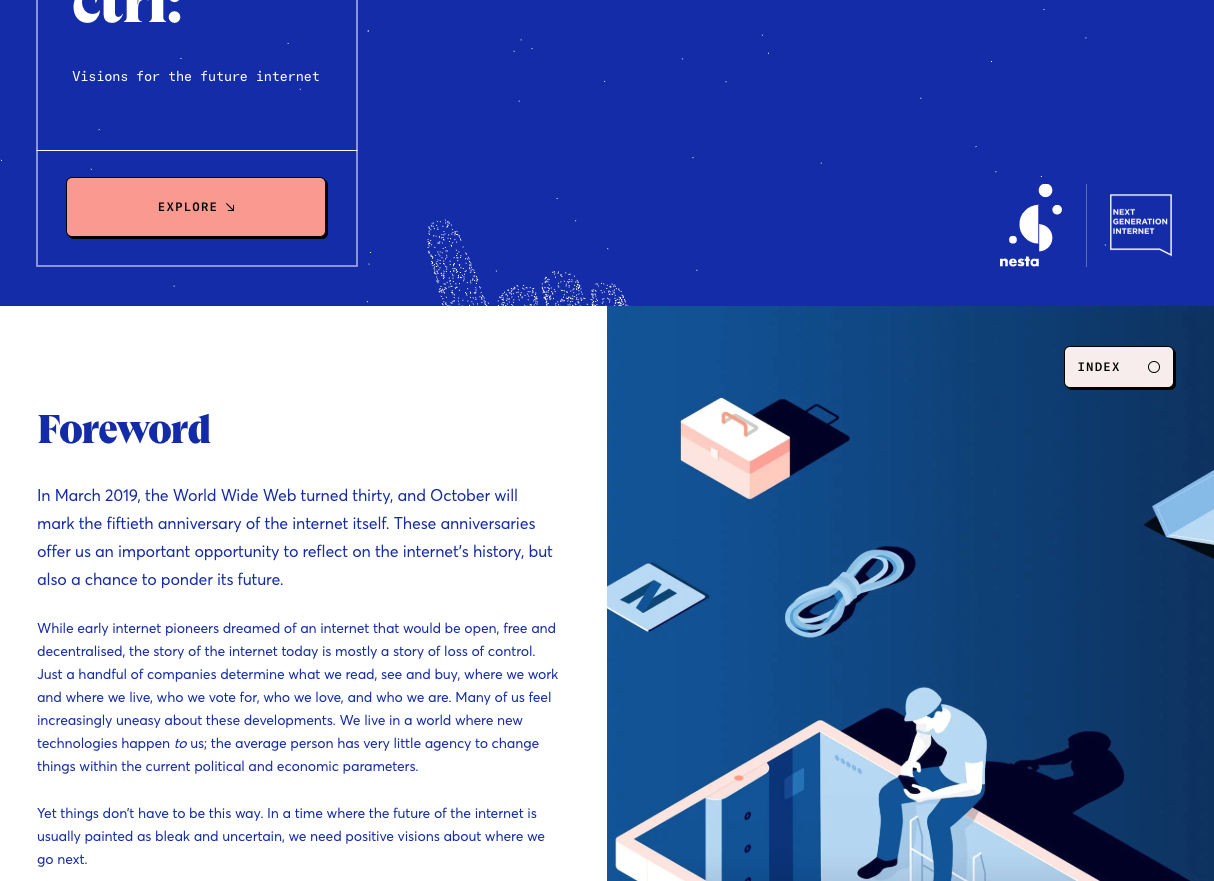
Hi MLE,
Just came across this site that I think you would really like.It is not some new site selling something, but rather it is part of the "Next Generation Internet (NGI) initiative" – the European Commission’s new flagship programme working on building a more democratic, inclusive and resilient internet. The NGI “hopes to empower everyone to take active control in shaping the future: the internet does not just belong to those who hold power today, but to all of us.”It's a beautiful site. An interactive timeline charts the past (eg: "Wikipedia founded in 2001") and the future (eg: "2039 we run out of lithium and can’t make new smartphones.")It also has lots of interesting articles including an interview with Oobah Butler, who famously got a completely fake restaurant to the top spot on TripAdvisor, who shows the flaws in the systems that influence us.It got me thinking about such things as "what happens when your language isn’t supported by apps, websites, and keyboards?"
Enjoy!Posted in: web